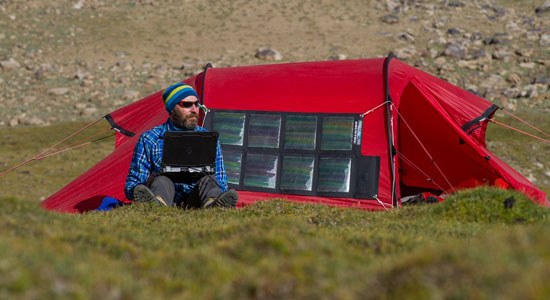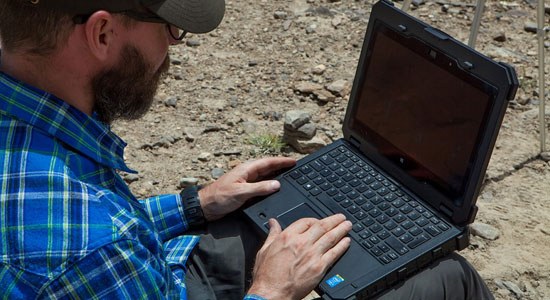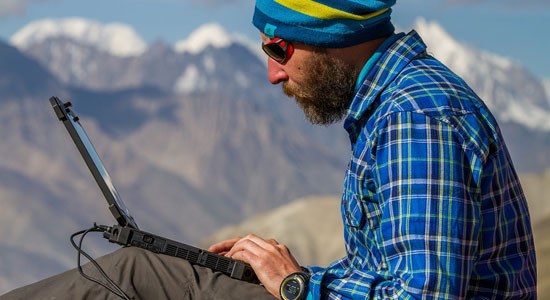The following is a guest post from Lars Larsson, a freelance journalist, photographer, filmmaker based in Åre, Sweden, and creator of the Sven Hedin Project. When he heard about how Martin Edstrom had used our technology to explore the world's largest cave, he wanted to see how it could aid his expedition to follow in famous Swedish explorer Sven Hedin's footsteps. What follows are his thoughts on the performance of our Dell Latitude 12 Rugged Extreme laptop during that journey.
************
I am a National Geographic Explorer and run a project where I am doing a series of expeditions to Asia in the footsteps of the Swedish explorer Sven Hedin (1865–1952). Hedin alone explored and mapped larger areas overland that were white spots on the world map than anybody else in history. That makes him one of the greatest explorers of all time. I travel in his footsteps, using his maps, diaries and photographs to follow up on his geographical and ethnographical observations. My objective is to determine and document how the landscape and culture have changed during the last century and my main method is repeat photography. This is at least a 10-year project and a journey that will take me up snow-clad mountain peaks, down wild rivers and through burning deserts in Central Asia.
In the summer of 2015 I completed the second stage in this expedition series – a journey through Kyrgyzstan, Tajikistan, Afghanistan and Xinjiang, China. The documentation produced from this expedition consists of many tens of hours of video footage, thousands of still photographs and a large quantity of 360 degree panorama photographs. I also extensively make use of geographic information system (GIS) software both as a method for locating the camera locations where Hedin shot his historic photographs and also for presenting my results in the form of interactive and immersive storytelling using Google Earth. All of this means that a computer for field use is one of the most essential pieces of equipment in my project.
On this expedition I got to try out Dell’s Latitude 12 Rugged Extreme, a convertible notebook, to see if it would meet the high demands on performance and durability required by my work.
Design and durability
The Latitude 12 Rugged Extreme has a chassis made of magnesium alloy with other parts in durable ultra-polymer. The immediate impression is that it looks like military grade equipment that is tough and durable, but still with a smooth and elegant design. Indeed it has been independently-certified to MIL-STD-810G standard, which is a US Military standard approved for all branches and agencies of the US Department of Defense. The full test results can be downloaded from Dell’s website, but just to mention something, this machine can survive 26 drops to the ground from an elevation of almost two meters. It is also certified to the ingress protection standard IP-65. This is the highest rating for dust, equivalent to complete protection against contact. The notebook cannot be submerged in water, but it resists splashes and even jets of water with no harmful effects.
The roads in Central Asia, in particular in the mountainous region of Pamir, are so dusty that all our equipment was covered with dust even inside our car during transport. The roads are so bad that a normal computer would probably have started to break just from the constant vibrations and bounces inside the car – going on for days on end. Not only did we use cars for transport, but also camels and donkeys, walking on narrow mountain trails with the threat of bags falling off into deep gorges. The rough handling when loading and unloading luggage from cars and animals is one of the most dangerous actions for the equipment. However, with knowledge of the solid construction of the Latitude 12 Rugged Extreme I was never nervous. The simple but effective bumpers on all four corners of the computer will absorb most of the shock from a fall.
Other design details worth mentioning are the smart covers on the ports. I like that Dell decided to make separate covers for small groups of ports instead of exposing all the ports with a big single cover. This minimizes exposure to the outside. The covers are very easy to open and close and have a smart locking mechanism in their closed state. One problem with the covers is that they can swing open more than 180 degrees, which means they often end up getting under the notebook. If you put the notebook down hard on a flat surface I see a potential that the cover’s hinges could break by being bended backwards. A possible solution might be to make the covers open less than 180 degrees.
Touch pad and keyboard
My first experience with the Latitude 12 Rugged Extreme was actually one of pure frustration. I had to set up the computer for my own needs and install a lot of new software under extreme time pressure, but the touch pad did not behave as I wanted it to – I dragged and dropped files and icons by mistake all over the place. The reason behind my frustration was that the Latitude 12 Rugged Extreme has a resistive touch pad. This means that you have to apply a little bit of pressure for it to work. With a capacitive touch pad or touch screen, which is most commonly used on non-rugged notebooks and smartphones, you merely need to have contact with the surface with your fingers. However, after spending some time getting used to the new touch pad and without the initial stress I learned to operate it properly without problems.
A capacitive touch pad is in my opinion superior under normal circumstances, but this notebook is not designed for that, it is made to excel during the most extreme conditions you can think of. I realized why the resistive touch pad and screen is superior in those conditions when I tried to use the notebook with gloves. It works just as good as without them. Even the thinnest of gloves will render a capacitive touch pad completely useless, but on the Latitude 12 Rugged Extreme both the touch pad and touch screen works perfectly. If you are studying high altitude glaciers and trying to ascend a mountain that is 7,546 meter high, like we did, it is very comforting to know that this machine has an operating thermal range between -29°C and 63°C (-20°F to 145°F) and can be operated without taking your gloves off. Despite my initial frustration I now fully appreciate the use of resistive technology in the touch pad.
The keyboard is in full scale with a well-balanced resistance in the keys. It also has a couple of cool special features. The keyboard is backlit which is great when working in dim light conditions. You can also change the default white color of the lighting to green, red or blue. This way you can adjust the lighting to any other colored light sources you might be using and preserve your night vision. There is also a stealth mode that makes it possible to shut down the screen and all light sources including all small diodes by just pressing a key combination.
Touch screen
Latitude 12 Rugged Extreme is marketed as the world’s first fully rugged convertible notebook. The screen has an innovative design, which makes it possible to rotate it 180 degrees within its frame, converting the notebook to rugged tablet. As already mentioned above, the touch screen is resistive and unlike capacitive screens it works great both in rain and with gloves. I am sure that the convertibility can be a huge advantage in some use cases, but speaking purely from a personal point of view I did not find much use of this feature. The main reason is because a lot of the work I need the computer for is graphical precision work that I actually prefer to even use a mouse for. I also use the keyboard a lot and cannot be without it. The drawback of such an extremely rugged notebook is that it is going to be heavy. Because of the weight, it does not feel pleasant to hold it like a tablet and therefore you naturally opt for notebook mode.
Convertibles definitely have their place in the toolbox, but they always have to be a compromise. Personally I would rather not compromise. In an ideal world I would have two different tools and then choose between them depending on the requirements of the mission at hand. Dell recently launched a new Latitude 12 Rugged tablet that sounds very interesting. If you want to go lighter and a tablet is sufficient, this would be the way to go. I would also have liked to see an option with a non-convertible notebook that would be even stronger, getting rid of the moving parts in the screen.
The Latitude 12 Rugged Extreme screen works very well in sunshine; however I found that the screen surface is prone to attract finger prints that can be difficult to remove. This is one more reason I was reluctant to use the tablet mode. Getting fingerprints all over the screen significantly decreases its visibility in direct sunlight.
Performance and battery
My work is very demanding when it comes to computer performance. We work with both digital still photography and digital video. Sometimes it can come in handy to be able to edit some small video clips in the field, even though that work usually takes place after returning home. It is an absolute necessity to be able to edit and work with still photographs while in the field. During repeat photography I often use tethered shooting where I connect my camera to the computer to be able to immediately see the results on the computer screen. This makes it possible to use image processing software to determine how accurate the image is and adjust the position of the camera while on location to get the best results. The GIS-software I use is also very demanding, but still the notebook did a very good job for its size and limitations. I tested a machine with a Core i5-processor but it is possible to get a configuration with a Core i7 and up to 16 GB memory, which would significantly improve the performance when working with heavy 3D-applications like GIS.
The battery time for a rugged computer for expedition use is one of the most crucial factors. The Latitude 12 Rugged Extreme showed good results for this and gave enough operating time to solve most tasks. I was happy with the battery time, considering the good computational performance, but I would still wish for more. The battery compartment is sealed off from the rest of the computer and it is very easy to change battery in the field. This makes it a viable option to bring extra batteries with you if other power sources are unavailable. I did not use extra batteries, but instead had a system with external batteries and solar panels from Brunton to power the computer even in the remotest mountain areas.
Ports, slots and features
The Latitude 12 Rugged Extreme I tested had one USB 3.0 port and one USB 2.0 port, this was not ideal for my purposes and in retrospect a better option for me would have been to replace the ExpressCard 54 mm/PCMCIA slot for a memory card reader and an additional USB 3.0 port. This option is available. There are also a native RS-232 serial port, RJ-45 gigabit Ethernet network connector, stereo headphone/microphone combo jack, pogo-pin docking connector, VGA and HDMI.
Most ports are placed in a convenient way, but I have a minor complaint when it comes to the headphone jack. Since all ports are protected by covers, you have to stick your fingers into the opening to be able to grip around the plugs and pull them out. The problem with the headphone jack is that it is placed so close to the left wall that you cannot get your finger in on the left side. That means it is difficult to get a grip around the plug and instead you might feel the necessity to pull in the cable itself. It is best to avoid this since it potentially could damage the cable connection to the plug itself.
The Latitude 12 Rugged Extreme has a solid state disk (SSD) that is compact and can handle shocks and vibrations much better than conventional disks. Another nice feature is that it can be removed from the computer within seconds if you by some reason have to abandon your equipment but need to save or destroy your important data.
Conclusion
As a National Geographic Explorer I plan my expeditions for years and I try to find the best gear available to complete my task. On our journey through Central Asia we had to tackle earth quakes, avalanches, mud flows, extreme flooding and alarming reports about Taliban activity in our close proximity. We traveled by cars on the worst roads I have ever seen and trekked with pack animals along narrow mountain trails. Despite the tremendous wear and tear on the equipment the Latitude 12 Rugged Extreme kept my data safe and met all the requirements for extreme outdoor use. I would recommend this computer to anyone that needs a truly rugged notebook that can operate in the harshest of conditions – be it a freezing snowstorm on high altitude, rain or the treacherous fine grained dust that eventually covered all our gear.
Above Images Credit: Ylva Olofsson



